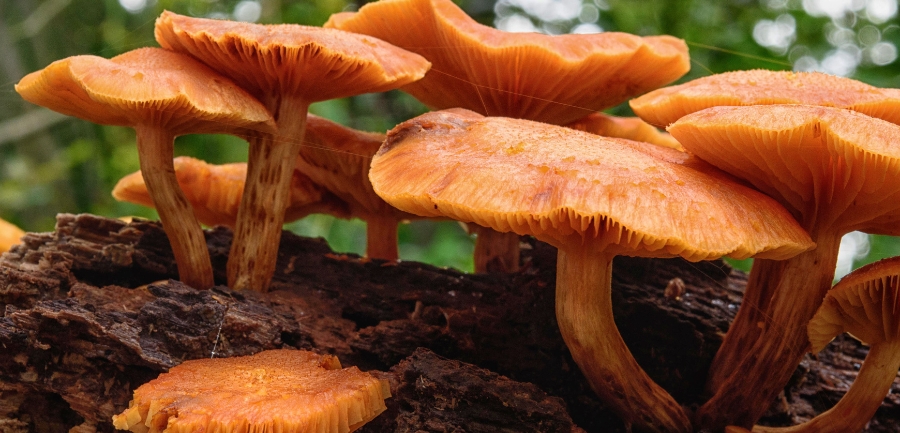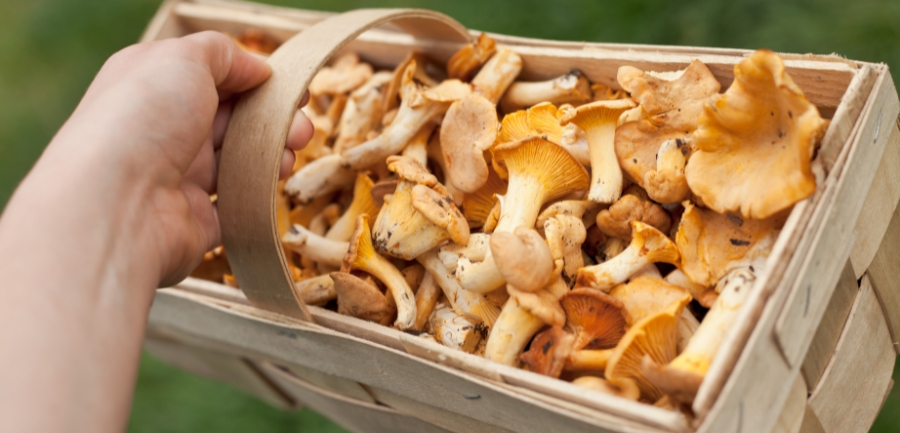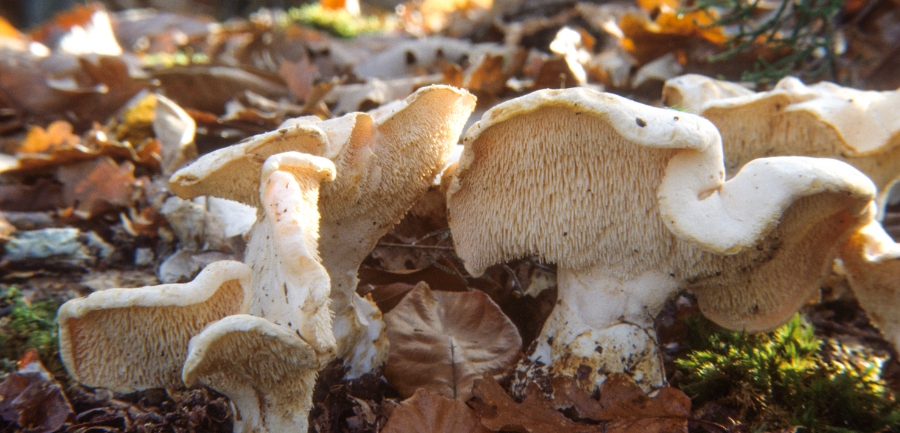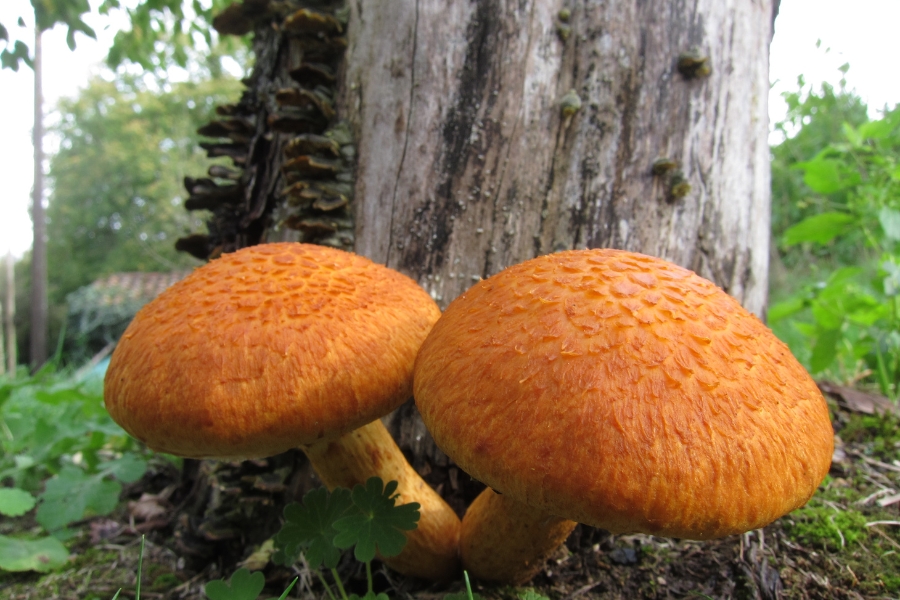There’s something undeniably captivating about an orange mushroom. Perhaps it’s their vivid hue or the way they make a surprise appearance in our gardens after a rain. Stumbling upon these vibrant fungi might leave you curious: “Is this one edible?” or “How did it get here?”
Table of Contents
From the soft caps that sprout in our lawns to the sturdy ones on tree trunks, orange mushrooms are a fascinating topic. So, whether you’re a keen gardener, a nature enthusiast, or just mushroom-curious, join me as we delve deeper into the world of these colorful fungi.
Orange Mushrooms Identification

Identifying mushrooms can feel a bit like piecing together a jigsaw puzzle, especially when it comes to orange ones. They can be strikingly similar yet subtly different. Let’s dive into the characteristics you should focus on.
Recognizing Features and Shapes
When I first delved into the world of mycology, I realized that identifying mushrooms goes beyond just looking at their caps. To truly understand what you’re observing, you need to focus on:
- Caps: The cap’s shape can be a tell-tale sign. Some orange mushrooms have flat, broad caps while others may be conical or even wavy.
- Stems: A quick check on the stem can reveal a lot. Is it thick or slender? Hollow or solid?
- Spore Prints: This might sound a bit technical, but trust me, it’s fascinating. If you place the cap of a mushroom on a white sheet of paper, it will release spores. The color of these spores can be a vital clue to the mushroom’s identity.
While these pointers will get you started, remember that the world of fungi is vast. But don’t get overwhelmed; the joy is in the journey. And the more you observe, the better you’ll get at distinguishing between different orange fungi.
Orange and Yellow Mushroom: Differences and Similarities
Now, here’s something that tripped me up in my early days. You see an orange mushroom. But wait, does it have yellowish tones? Let’s decode this:
- Purely Orange Mushrooms: These have a consistent, bright orange hue across the cap and stem. Think of the classic toadstool look, but all in orange.

- Orange and Yellow Varieties: These are more of a gradient. They might start with a deep orange center on the cap, fading to yellow at the edges.

Why is this distinction important? Color variations are crucial in identification. Two mushrooms might have similar shapes but different hues. Recognizing these nuances can mean the difference between identifying an edible variety and a toxic one.
Orange Mushroom in Yard: Friend or Foe?
If you’ve ever spotted an orange mushroom sprouting in your yard, you might’ve had a mix of wonder and worry. I’ve been there too! Let’s understand these surprise guests a bit better.
Common Species Found in Yards
There’s an array of orange mushrooms that could decide to make a cameo in your yard. While I won’t be able to list every single one (oh, how I wish I could!), I’ll share a few commonly found varieties:
- Chanterelles: These are golden-orange and trumpet-shaped. They’re also edible and quite sought after in culinary circles.

- Jack-O-Lantern: Bright and beautiful, but be cautious, they’re toxic!

- Orange Mycena: These tiny wonders have a delicate appearance with bell-shaped caps.

But why do they pop up in our yards? Mushrooms, including our orange friends, are nature’s recyclers. They break down organic matter, aiding in decomposition and thereby enriching the soil. So, while they might seem like uninvited guests, they’re silently doing beneficial work for your garden’s ecosystem.
Safety Tips and Considerations
While mushrooms are incredible, there’s a side of caution we should always exercise, especially when kids and pets are around.
- Pets and Children: Always supervise them outdoors. An innocent-looking mushroom might be toxic if consumed. Teach kids never to pick or eat any wild mushrooms.
- Suspicious Mushrooms: If you’re ever in doubt about a mushroom’s identity or safety:
- Take a photo and use identification apps or consult with local mycology groups.
- Consider wearing gloves when removing them.
- Dispose of them safely, out of reach of children and pets.
Orange Edible Mushrooms: Delightful Delicacies
There’s something immensely satisfying about incorporating wild, edible mushrooms into a meal. Not only do they tantalize our taste buds, but they also evoke a sense of connection to nature. Let’s delve into the mouthwatering world of orange edible mushrooms.
Popular Edible Varieties
The world of fungi is as delicious as it is diverse. Among the myriad of mushrooms, certain orange ones have carved a niche in the culinary realm.
- Chanterelles: These are a gourmet’s dream. With their fruity aroma and slightly peppery taste, they’re a treat in sautés and risottos.

- Hedgehog Mushrooms: Named for their spiky, gill-like undersides, these have a nutty flavor that pairs beautifully with pasta dishes.

- Orange Milkcap: With their rich and creamy texture, they’re ideal for soups and stews.

Preparing and Enjoying Them:
- Clean them gently with a soft brush to remove dirt.
- Sautéing in butter or olive oil helps to bring out their natural flavors.
- Remember, always cook wild mushrooms thoroughly before consumption.
Safety First: Avoiding Toxic Varieties
As much as I love mushrooms, it’s essential to approach foraging with a dose of caution.
- Lookalikes: Some toxic mushrooms can closely resemble edible ones. For instance, the toxic Jack-O-Lantern can be mistaken for the edible Chanterelle.
- Odor Test: While not foolproof, a pungent or unusual smell can sometimes indicate a mushroom isn’t fit for consumption.
Foraging Best Practices:
- When in doubt, leave it out. It’s better to skip an unknown mushroom than to risk it.
- Attend local mushroom foraging workshops or go with experienced foragers.
- Invest in a good mushroom field guide specific to your region.
Orange Wild Mushrooms: A Naturalist’s Perspective
Nature has a wondrous way of continually surprising us. Every time I’ve trodden forest paths or wandered through meadows, wild mushrooms have been like little treasures dotting the landscape. These orange wonders, in particular, tell a tale of ecosystems, symbiotic relationships, and nature’s intricate balance.
Habitats and Locations
Embarking on the quest for wild orange mushrooms is akin to an adventure. The thrill of discovery is unmatched! But knowing where to look can turn your casual walks into fruitful forays.
- Forests: Many orange mushrooms love the dense, moist environment of woodlands. Look around decaying logs, mossy areas, and shaded grounds.
- Grassy Meadows: Some varieties prefer open spaces, thriving amidst grass and underbrush.
- Near Streams and Wetlands: The damp environment is conducive to a few orange mushroom species, offering them the moisture they crave.
Understanding Their Natural Environments: Each mushroom has a preferred microhabitat. While one might flourish on decaying wood, another might seek the root systems of living trees. Observing these nuances enhances our understanding and appreciation of these fungi.
Contribution to the Ecosystem
Beyond their captivating appearance, these fungi play vital roles in nature, often unseen but profoundly impactful.
- Decomposition Masters: Mushrooms break down complex organic matter, from fallen leaves to decaying trees. This process releases essential nutrients back into the soil, supporting plant growth.
Symbiotic Relationships: Some mushrooms, like mycorrhizal fungi, form partnerships with plants and trees. The fungi provide the plants with nutrients while receiving sugars in return. This relationship enhances plant health and growth.
Orange Mushroom on Tree: What Does It Mean?

Trees are majestic beings, standing tall and witnessing the world’s ebb and flow. But have you ever noticed an orange mushroom clinging to a tree trunk or sprouting from its base? It’s not just a random occurrence but a tale of interactions, health, and nature’s profound connectivity.
Common Tree-Fungi Interactions
When strolling through a wooded area or even observing the trees in a local park, the sight of mushrooms growing directly on them is quite intriguing.
- Bracket or Shelf Fungi: These are among the most common tree-borne mushrooms. With their shelf-like structure, they can be found jutting out from tree trunks. Their colors can range from muted browns to vibrant oranges.
- Mycorrhizal Mushrooms: While not always visible, these fungi form connections with tree roots, engaging in a mutual exchange of nutrients.
Understanding Their Significance: The presence of mushrooms on or around a tree is often an indicator of the tree’s health and the surrounding environment. For instance, some fungi help decompose dead wood, aiding in the natural recycling process.
Implications for Tree Health
The relationship between trees and fungi can be beneficial, neutral, or even harmful. The key lies in identifying which is which.
- Beneficial Partnerships: As mentioned, mycorrhizal fungi and trees have a mutualistic relationship. The tree provides sugars to the fungi, while the fungi offer essential minerals to the tree.
- Potential Harms: On the other hand, certain fungi can be pathogenic, causing diseases or decay in trees. For instance, when you see mushrooms sprouting from a tree trunk, it might indicate internal decay.
Signs of a Tree in Distress:
- Fungal growth near the base or on the trunk.
- Discoloration of bark or leaves.
- Premature leaf drop or noticeable branch dieback.
What to Do: If you suspect a tree is in distress due to fungal growth:
- Consult with an arborist or tree specialist.
- Avoid any drastic measures, like cutting down the tree, without professional advice.
To Wrap It Up!
Orange mushrooms, with their captivating hues and diverse forms, are more than just woodland wonders. They’re nature’s storytellers, narrating tales of ecosystems, symbiotic bonds, and the delicate balance of life.
Whether sprouting in our yards, garnishing our plates, or clinging to ancient trees, they serve as reminders of nature’s interconnectedness and the beauty that arises from it. So, the next time you spot one of these vibrant fungi, take a moment to appreciate its role in the grand tapestry of our environment. Happy mushrooming!
FAQs
What is the orange mushroom called?
The orange mushroom is commonly referred to as the “Chanterelle.” They’re distinctively trumpet-shaped with a golden-orange hue.
Can I eat this orange mushroom?
Yes, Chanterelles are edible and are highly sought after in culinary circles. However, always ensure correct identification before consumption.
Are orange mycena poisonous?
Orange Mycena, while not deadly, is not considered edible. Consuming them can cause mild gastrointestinal discomfort in some individuals.
What mushroom has an orange top?
Several mushrooms have orange tops, but the most notable is the Chanterelle. It’s easily recognizable by its vibrant orange cap and unique shape.

